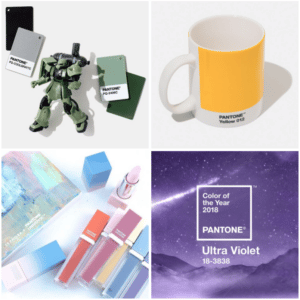Don’t underestimate the power of a question-led narrative. Whether the brand is your company or yourself, it matters which side of the equation you’re on.
If you ever want to know who is controlling the narrative in a space, just look at who is asking the questions.
Pantone is asking the questions in the design industry.
Every Pantone chip, mug, makeup palette and Color Of The Year announcement asks the question, “What can color mean to us?”

Asking questions leads to a path forward.
Answering questions leads to a dead end.
Crayola, perhaps the only other ubiquitous color brand, has chosen to answer instead of ask. Their recent moves, including an iPad app launch and new crayon color announcement, are part of an effort to stay relevant with tech-first kids.
Their answer is, “This is what color should mean to you.”
Just like Pantone they, too, own a finite set of colors upon which all of their products are based. Just like Pantone, they’ve experienced an influx of new competitors, lower barriers to entry and a rapidly changing user.
But unlike Pantone, they’ve moved down a path of narrative dead ends.
A Storyteller’s Advice: Don’t answer when you can ask.
The best apples-to-apples comparison between these two brands is how they approach their biggest color events.
Pantone’s Color Of The Year has been described (and received) very differently than Crayola’s announcement of a new crayon color.
Here’s a telling excerpt from Pantone’s press release for 2018’s Color Of The Year, Ultra Violet:
We are living in a time that requires intensiveness and imagination. It is this kind of creative inspiration that is indigenous to PANTONE 18–3838 Ultra Violet, a blue-based purple that takes our awareness and potential to a higher level. From exploring new technologies and the greater galaxy, to artistic expression and spiritual reflection, intuitive Ultra Violet lights the way to what is yet to come.
Here’s an excerpt from Crayola’s press release announcing the new Bluetiful crayon to replace Dandelion Yellow:
“Four months ago, we invited North America to be a part of Crayola history and help us name our new blue crayon color, and today, that became a reality,” said Melanie Boulden, Senior Vice President of U.S. and Global Marketing at Crayola. “Thanks to our fans’ passion and creativity, our new blue has an awesome new name. The name Bluetiful exudes creativity and originality. We couldn’t be more excited to welcome new Bluetiful to the Crayola color family.”
Crayola’s new crayon fails to mean anything because it there is no larger question behind it.
Pantone’s Color of The Year means something to us because the question behind it helps us discover something about ourselves. That’s what questions do.
Questions offer the promise of new knowledge.
Answers make knowledge finite.
We won’t wait for the next Crayola crayon, but we will definitely wait for the Pantone color of 2019.
More specifically, we will wait for the color of 2019 to reveal something — and questions tend to reveal a lot more than answers.
These two brands have very different audiences, but you can still reveal something about children (or the child in every adult) to themselves. Lego and Disney have demonstrated this masterfully.
Questions are important because they not only give you movement, but latitude as well.
Pantone has successfully leapt product categories, consumer groups and cultural boundaries in ways that Crayola hasn’t been able to because they were following a question as their North Star. When we experience the Pantone brand, we encounter that question, and discover a bit more about what color can mean to us.
It’s easy to trap yourself with an answer. Answers deliver value… but questions deliver meaning.
I tell stories for our brands in the same way — by inspiring curiosity, and then chasing that curiosity into powerful brand identity, positioning, defensible market moves, communication strategies, product launches and organizational focus.
When you find the right question, trust that it will take you where you need to go.
A Publicist’s Advice: Never let someone ask you the wrong question.
Before my company Concept Bureau was a brand strategy agency, we were a PR agency called J.B. Communications.
While we still do PR strategy for our clients, I’m not on the ground managing media anymore. But back when I was, there was one red flag that I trained all clients to watch out for.
Never let someone ask you the wrong question.
If you ever get that terrible feeling that you’re in a position of weakness when someone asks you something, or if you know there is no good way to answer a question without the other person gaining an upper hand, it’s likely because you’re being asked the wrong question to begin with.
That’s happened to me twice recently.
The first time, I was able to successfully reverse the situation. The second time, I slipped and lost control of the narrative, but I know exactly what I should have done differently.
A service provider I had a verbal work-trade agreement with recently sold her practice and left me with a high balance of hours I had no way of recouping… something I only learned of when I inquired about it a few weeks later.
Her response was that although she could no longer provide the original service hours she owed me, she would be glad to work out whatever agreement I thought was fair.
Sounds reasonable.
But think about that for a moment… that’s not an answer. That’s a question asking me what do you want to do about it?
That question put me in a position of weakness because it required me to find the solution to a problem that 1) I hadn’t created, and 2) would never have all of the information for.
How could I know what a good agreement would look like when she’s the only one who knows what she can truly offer me?
She was trying to ask me the wrong question.
The correct conversation for this situation was not about how I could find a solution. It was about how she could find it… and so my response to her was, “What options do we have?”
Even if her response was to lowball me, I would be able to negotiate something from a position of power.
The person, brand or entity asking the questions is the one in charge because they dictate the possible range of answers.
You don’t shape a conversation by providing the words. You shape it by creating the context.
Sometimes people want to have the same conversation as you, but they’re just starting in the wrong place.
Other times, however, they want to pin you down in an unfavorable situation.
When my husband told me we could go on a free helicopter ride this past weekend, I was excited. But there was one catch — it was part of a sales ploy and we’d have to sit through a 90-minute timeshare presentation by Hyatt Residences first.
We were on vacation for his birthday, so after resisting for a good bit (and considering my husband’s argument that as bad as a timeshare sales presentation may be, it‘s’ one of those wonderfully terrible cultural experiences everyone should live through at least once), I agreed.
At the very end of our conversation with the timeshare sales agent, after nearly and hour and a half of dodgy explanations and complicated point systems, the discussion came to an interesting point.
As she ‘calculated’ our ROI, she asked us how long we expect to travel.
Me: “Let’s do it over an 8 year horizon and see what that looks like.”
Agent (tone suddenly condescending): “8 years? So you’re just gonna burn all of your luggage after that and stay at home forever?
Me: “No… I mean we’ll still travel… I just kinda wanna know what it might look like after 8 years. It would be good to know if we do this for 8 years, what kind of situation we’d be in. Of course we’d still keep traveling, though…”
No. Wrong response.
What I should have done was refuse to let her ask me the wrong question.
A strong response from me would have been the counter question, “Will I need to wait more than 8 years before this is even worth my money?”
When I answered her question the way I originally did, I let her make the conversation about whether I was qualified for a timeshare, instead of changing the context altogether to ask if her timeshare product was worth my time.
If you’re explaining, you’re losing. Let other people sell to you. Don’t let them make you sell.
It’s ok, though. We finally got the free helicopter ride.
Finding ways to ask at the right time is crucial.
Just as important, however, is asking the right questions to begin with.
A Strategist’s Advice: Make the conversation bigger.
As a brand strategist, I’m always looking for the conversation that can’t be leapfrogged. Great brands have that one huge question that can’t go unanswered.
Strategic storytelling takes that question and pushes it forward.
Branding, accordingly, happens between the lines. Brands effectively ask questions through their actions, their decisions and their perspectives.
When you or your brand are faced with a narrative that serves someone other than yourself, take that narrative and make it bigger.
Upstart food, beauty, health and consumer brands that lived in ecosystems run by the P&Gs and Unilevers of the world did exactly that by starting the ‘X-free’ conversation: gluten-free, dairy-free, sulfate-free, chemical-free, cruelty-free, conflict-free.
They asked, “What are we putting in our bodies? What are we doing to the world?” and forced major brands to answer for the first time ever.
Those are questions much bigger than “How established is your brand?”
Questions, unlike answers, are less threatening and prescriptive. It’s akin to the difference between Do it this way or instead Wouldn’t it be nice to do it this way?
When we ask, we untether the conversation from ourselves and make it instead about the larger progression of an idea.
LPT: An argument is when you are trying to determine WHO is right, a conversation is when you are trying to determine WHAT is right.
Answering, of course, does have its place. But there are really only two people you need to ever answer to: the consumer and yourself.
Amazon, Facebook and Google know that. They don’t even answer to the government.
They get away with it because they’ve successfully asked the big questions for so long, that at some point we began to trust them more than our own institutions. Public backlashes may come and go, but every day that we log into our Amazon, Facebook and Google accounts, we are voting for the askers.
Google I/O, iPhone launches and Facebook developer events are annual pilgrimages to hear the big questions being asked.
CES is where everyone else tries to answer them.
Watch me break down this concept and dig into these examples in the video below:
Making the equation work for you.
Ask yourself if you’re on the right side of the conversational equation:
- Are you asking the big questions in your industry, or are you answering your competitor’s questions?
- Do your tactical and marketing strategies explore a bigger idea?
- Is your product strategy dictated by your brand strategy, or the other way around?
- Does your brand’s narrative also reveal a clear market path?
- Can you move into new categories and new consumer psychographics without compromising the integrity of your brand?
Asking can be very powerful and illuminating.
Those that are brave enough to follow that path are also the ones that commit to constant exploration. There is more value in moving the conversation forward than in merely satisfying it today.
Consumers know that, too, and that is why they reward those brands that continuously inquire.
You can always flip the script for your brand.
It all starts with a question.




